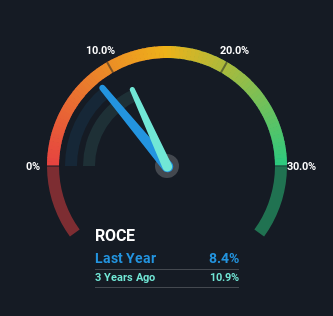Samuel Heath & Sons (LON:HSM) Hasn't Managed To Accelerate Its Returns
There are a few key trends to look for if we want to identify the next multi-bagger. Firstly, we'll want to see a proven return on capital employed (ROCE) that is increasing, and secondly, an expanding base of capital employed. Basically this means that a company has profitable initiatives that it can continue to reinvest in, which is a trait of a compounding machine. Although, when we looked at Samuel Heath & Sons (LON:HSM), it didn't seem to tick all of these boxes.
What Is Return On Capital Employed (ROCE)?
For those that aren't sure what ROCE is, it measures the amount of pre-tax profits a company can generate from the capital employed in its business. To calculate this metric for Samuel Heath & Sons, this is the formula:
Return on Capital Employed = Earnings Before Interest and Tax (EBIT) ÷ (Total Assets - Current Liabilities)
0.084 = UK£990k ÷ (UK£14m - UK£2.4m) (Based on the trailing twelve months to March 2023).
Therefore, Samuel Heath & Sons has an ROCE of 8.4%. On its own, that's a low figure but it's around the 9.8% average generated by the Building industry.
Check out our latest analysis for Samuel Heath & Sons
Historical performance is a great place to start when researching a stock so above you can see the gauge for Samuel Heath & Sons' ROCE against it's prior returns. If you're interested in investigating Samuel Heath & Sons' past further, check out this free graph of past earnings, revenue and cash flow.
So How Is Samuel Heath & Sons' ROCE Trending?
Things have been pretty stable at Samuel Heath & Sons, with its capital employed and returns on that capital staying somewhat the same for the last five years. This tells us the company isn't reinvesting in itself, so it's plausible that it's past the growth phase. With that in mind, unless investment picks up again in the future, we wouldn't expect Samuel Heath & Sons to be a multi-bagger going forward.
In Conclusion...
In summary, Samuel Heath & Sons isn't compounding its earnings but is generating stable returns on the same amount of capital employed. And investors may be recognizing these trends since the stock has only returned a total of 15% to shareholders over the last five years. So if you're looking for a multi-bagger, the underlying trends indicate you may have better chances elsewhere.
If you want to know some of the risks facing Samuel Heath & Sons we've found 4 warning signs (1 makes us a bit uncomfortable!) that you should be aware of before investing here.
While Samuel Heath & Sons isn't earning the highest return, check out this free list of companies that are earning high returns on equity with solid balance sheets.
Have feedback on this article? Concerned about the content? Get in touch with us directly. Alternatively, email editorial-team (at) simplywallst.com.
This article by Simply Wall St is general in nature. We provide commentary based on historical data and analyst forecasts only using an unbiased methodology and our articles are not intended to be financial advice. It does not constitute a recommendation to buy or sell any stock, and does not take account of your objectives, or your financial situation. We aim to bring you long-term focused analysis driven by fundamental data. Note that our analysis may not factor in the latest price-sensitive company announcements or qualitative material. Simply Wall St has no position in any stocks mentioned.

 Yahoo Finance
Yahoo Finance 
